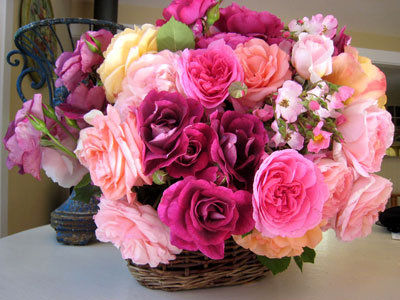
The weather this year has agreed with my roses. It might seem like we’re living in England lately, but the roses have appreciated the cool, damp spring. All the better to set lots of buds, without a sudden heat wave to ruin the show. Every rose lover I’ve talked to is raving about the quality, quantity and extended bloom time for their roses.
Roses are available in so many shapes, sizes, colors and fragrances that almost every garden has a place for at least one. They provide structure and proportion to the landscape and are among the most showy and hardworking of all garden plants. The rose was selected as our national flower in 1986. England may have a few years on us in that department, though, as it’s been their national emblem since the Wars of the Roses in 1455.
Who grew the first rose? Fossilized plants more than 30 million years old can be linked to modern rose species. The Chinese were probably the first to cultivate roses, however. In 500 B.C., Confucius wrote of roses in the Imperial Gardens, and roses were introduced to the European market in the late 18th century.
The ancient Greeks also cultivated roses extensively, and the Romans imported roses from Egypt. They also established a thriving rose-growing industry south of Rome, forcing them into bloom during the winter in greenhouses and by irrigating with warm water.
In the genus Rosa, there are more than 150 species or styles of roses that have specific characteristics. These species roses are plants that grow in the wild, from which all other roses are descended. Hybridization happens in nature by bees and other insects, but man has taken the process to an intricate art, and hybrid roses now account for more than 1,000 different kinds. From old garden roses like Damask and Bourbon to modern roses like hybrid tea, floribunda and grandiflora to tree roses, climbing roses, miniatures, the choices are endless.
Which types grow well here in the Santa Cruz Mountains?
From my own experience and that of other designers and rose aficionados, my all-time favorite is the popular Sally Holmes. The disease-resistant, ever-blooming flower handles our summer heat and winter cold with ease and has few thorns. Large, long-lasting clusters of single peachy-white blooms cover this 10-foot spreading shrub that acts more like a climber. Because the flower is simple in form and doesn’t have many petals, it can handle foggy, cool conditions and resists fungal diseases.
English roses, such as Golden Celebration, need warmth to perform well. With 5-inch blooms of 50-plus petals, they are reliable if you get lots of heat. Same goes for the rich, golden-yellow Graham Thomas rose. Both are fragrant.
Roses that I have found to bloom in shady conditions include Ballerina, a wonderfully fragrant, small, pink hybrid musk rose. Dense, hardy and vigorous, it’s easy to grow. I also grow the magenta climber Zepherine Drouhin in the shade. It grows to 8 to 12 feet tall and has a strong raspberry scent.
Iceberg performs well in partial shade, too, with large, double, pure-white blooms that scent the air with a rich, honey perfume. I like that it’s thornless, too. I’ve been told that the miniature, Gourmet Popcorn, also tolerates shade.
Beware, though: Deer love to eat roses. Even roses with terrible thorns have susceptible new growth before the thorns have had time to harden. The new growth also has an increased amount of nutrients. I’ve heard that Rugosa roses are fairly deer resistant, as well as the Fairy rose.
This column is not long enough to go into the best ways to plant and grow roses. But if you have a choice, it’s best to plant them where they receive at least morning sun, as this allows the foliage to dry before fungus spores take hold.
Every garden or patio has a place for at least one wonderfully fragrant rose.
Jan Nelson, a landscape designer and California certified nursery professional at Plant Works in Ben Lomond, will answer questions about gardening in the Santa Cruz Mountains. E-mail her at ja******@*ol.com, or visit www.jannelsonlandscapedesign.com to view previous columns and pictures.












